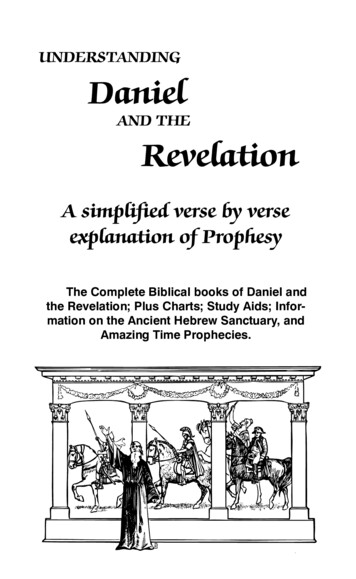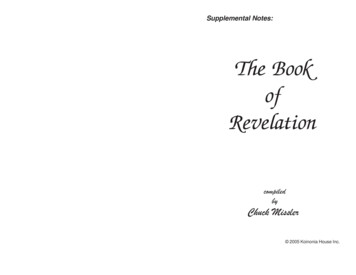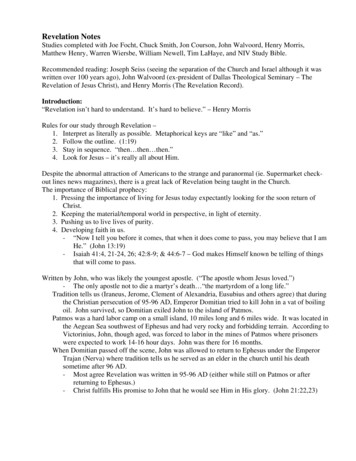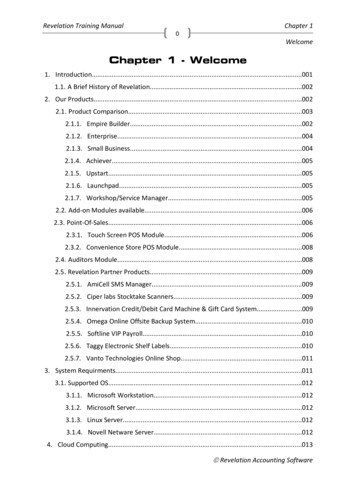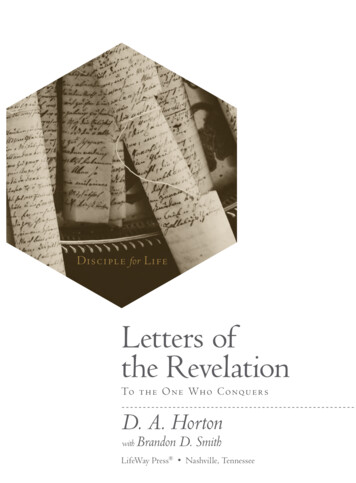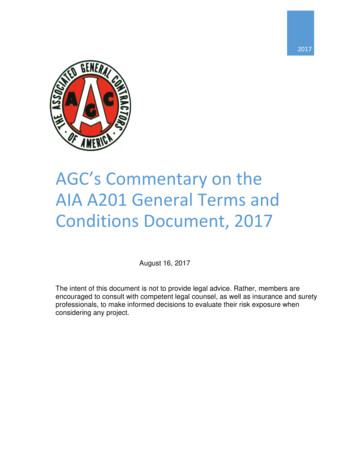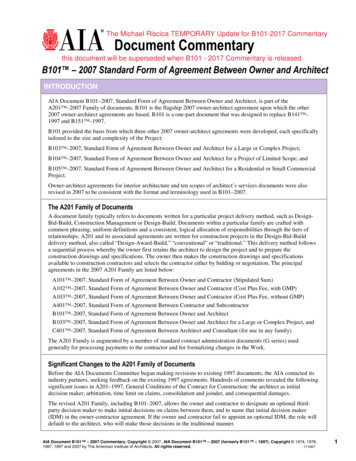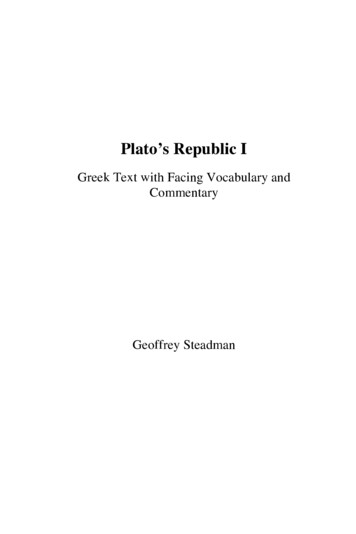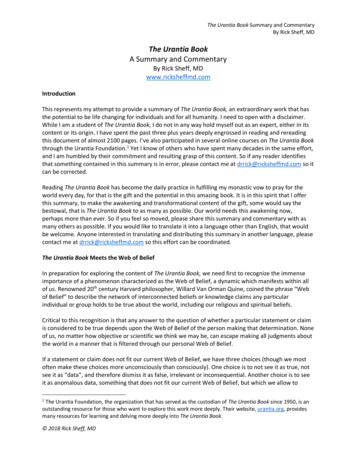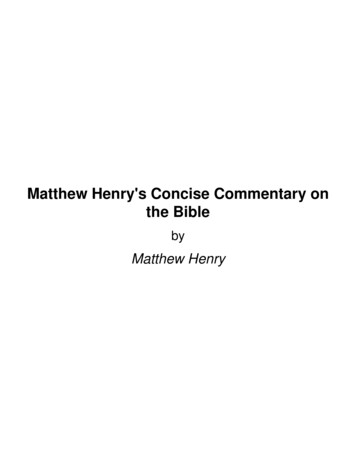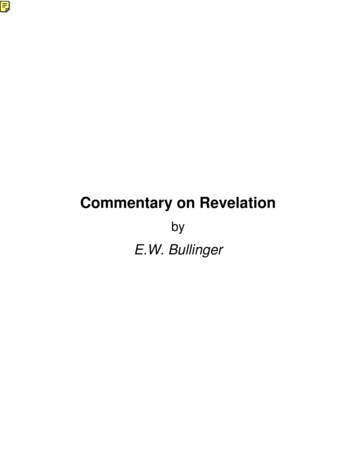
Transcription
Commentary on RevelationbyE.W. Bullinger
About Commentary on Revelation by E.W. BullingerTitle:URL:Author(s):Publisher:Print Basis:Rights:Date Created:CCEL Subjects:LC Call no:LC Subjects:Commentary on lypse.htmlBullinger, E.W. (1837-1913)Grand Rapids, MI: Christian Classics Ethereal LibraryF.H. Revell, 1909Public Domain2003-06-10All; Bible; Theology;BS2825 .B83 1984The BibleNew TestamentSpecial parts of the New Testament
Commentary on RevelationE.W. BullingerTable of ContentsAbout This Book. . . . . . . . . . . . . . . . . . . . . . . .Introductory. . . . . . . . . . . . . . . . . . . . . . . . . . .THE FIVE-FOLD DIVISION OF THE BIBLE. . . . .THE HEBREW CHARACTER OF THE BOOK. . .THE CHURCH NOT THE SUBJECT OFPROPHECY. . . . . . . . . . . . . . . . . . . . . . . . .THE LORD'S DAY. . . . . . . . . . . . . . . . . . . . . .THE TITLES OF CHRIST. . . . . . . . . . . . . . . . .THE SON OF MAN. . . . . . . . . . . . . . . . . . . .THE ALMIGHTY. . . . . . . . . . . . . . . . . . . . . .LORD GOD. . . . . . . . . . . . . . . . . . . . . . . . .THE FIRST AND THE LAST. . . . . . . . . . . . . .THE PRINCE OF THE KINGS OF THE EARTH.WHO IS TO COME. . . . . . . . . . . . . . . . . . . .THE LIVING ONE. . . . . . . . . . . . . . . . . . . . .THE PEOPLE OF THE BOOK. . . . . . . . . . . . .THE TITLE OF THE BOOK. . . . . . . . . . . . . . .THE DESCRIPTIONS OF THE BOOK. . . . . . . .THE WORD OF GOD. . . . . . . . . . . . . . . . . .THIS PROPHECY. . . . . . . . . . . . . . . . . . . . .THE TESTIMONY OF JESUS CHRIST. . . . . . .CERTAIN EXPRESSIONS IN CHAPS. i. - iii. . . .UNTO HIM THAT LOVED US. . . . . . . . . . . . .KINGS AND PRIESTS. . . . . . . . . . . . . . . . . .HIS FATHER. . . . . . . . . . . . . . . . . . . . . . . .KINGDOM AND PATIENCE. . . . . . . . . . . . . .OUT OF HIS MOUTH WENT A SHARP TWO. . .A GREAT VOICE. . . . . . . . . . . . . . . . . . . . .HE THAT HATH AN EAR. . . . . . . . . . . . . . . .THE CHARACTER OF CHRIST'S ADVENT (i. 7).THE VISION OF THE SON OF MAN. . . . . . . . .THE COMPLEMENT OF GENESIS. . . . . . . . . .THE SUMMARY OF ITS CONTENTS (i. 19). . . .THE SEVEN ASSEMBLIES AS A WHOLE (i.11). .EPHESUS . . . . . . . . . . . . . . . . . . . . . . . . .iii.OLD. . . . . . . . . p. ii. . . . . . . . . p. 1. . . . . . . . . p. 2. . . . . . . . . p. 2TESTAMENT. . . . . . . . . p. 4. . . . . . . . . p. 5. . . . . . . . . p. 7. . . . . . . . . p. 8. . . . . . . . . p. 9. . . . . . . . . p. 10. . . . . . . . . p. 10. . . . . . . . . p. 11. . . . . . . . . p. 11. . . . . . . . . p. 12. . . . . . . . . p. 14. . . . . . . . . p. 16. . . . . . . . . p. 18. . . . . . . . . p. 18. . . . . . . . . p. 19. . . . . . . . . p. 20. . . . . . . . . p. 21. . . . . . . . . p. 21. . . . . . . . . p. 23. . . . . . . . . p. 24. . . . . . . . . p. 24. . . . . . . . . p. 25. . . . . . . . . p. 25. . . . . . . . . p. 26. . . . . . . . . p. 27. . . . . . . . . p. 29. . . . . . . . . p. 30. . . . . . . . . p. 32. . . . . . . . . p. 33. . . . . . . . . p. 38
Commentary on RevelationE.W. BullingerSMYRNA . . . . . . . . . . . . . . . . . . . . . . . . . . . . . . . . . . . . .PERGAMOS . . . . . . . . . . . . . . . . . . . . . . . . . . . . . . . . . . .THYATIRA . . . . . . . . . . . . . . . . . . . . . . . . . . . . . . . . . . . .SARDIS . . . . . . . . . . . . . . . . . . . . . . . . . . . . . . . . . . . . . .PHILADELPHIA . . . . . . . . . . . . . . . . . . . . . . . . . . . . . . . . .LAODICEA . . . . . . . . . . . . . . . . . . . . . . . . . . . . . . . . . . . .THE PROMISES TO THE SEVEN ASSEMBLIES. . . . . . . . . . . .THE FIRST . . . . . . . . . . . . . . . . . . . . . . . . . . . . . . . . . . . .THE SECOND . . . . . . . . . . . . . . . . . . . . . . . . . . . . . . . . . .THE THIRD . . . . . . . . . . . . . . . . . . . . . . . . . . . . . . . . . . .THE FOURTH . . . . . . . . . . . . . . . . . . . . . . . . . . . . . . . . . .THE FIFTH . . . . . . . . . . . . . . . . . . . . . . . . . . . . . . . . . . . .THE SIXTH . . . . . . . . . . . . . . . . . . . . . . . . . . . . . . . . . . . .THE SEVENTH . . . . . . . . . . . . . . . . . . . . . . . . . . . . . . . . .THE SCOPE OF THE APOCALYPSE SHEWN BY ITS PLACE INCANON. . . . . . . . . . . . . . . . . . . . . . . . . . . . . . . . . . . . . . . . .THE SCOPE OF THE APOCALYPSE SHEWN BY ITS STRUCTURE.The Introduction: Chapter 1. . . . . . . . . . . . . . . . . . . . . . . . . . . .The People on the Earth: Chapters 2-3. . . . . . . . . . . . . . . . . . . .The First Vision in Heaven: Chapters 4-5. . . . . . . . . . . . . . . . . . .The First Vision on Earth. . . . . . . . . . . . . . . . . . . . . . . . . . . . .The Second Vision in Heaven. . . . . . . . . . . . . . . . . . . . . . . . . .The Second Vision On Earth. . . . . . . . . . . . . . . . . . . . . . . . . . .The Third Vision In Heaven. . . . . . . . . . . . . . . . . . . . . . . . . . . .The Third Vision On Earth. . . . . . . . . . . . . . . . . . . . . . . . . . . . .The Fourth Vision In Heaven. . . . . . . . . . . . . . . . . . . . . . . . . . .The Fourth Vision On Earth. . . . . . . . . . . . . . . . . . . . . . . . . . . .The Fifth Vision In Heaven. . . . . . . . . . . . . . . . . . . . . . . . . . . .The Fifth Vision On Earth. . . . . . . . . . . . . . . . . . . . . . . . . . . . .The Sixth Vision In Heaven. . . . . . . . . . . . . . . . . . . . . . . . . . . .The Sixth Vision On Earth. . . . . . . . . . . . . . . . . . . . . . . . . . . . .The Seventh Vision In Heaven. . . . . . . . . . . . . . . . . . . . . . . . . .The Seventh (And Last) Vision On Earth. . . . . . . . . . . . . . . . . . .The People of the New Earth. . . . . . . . . . . . . . . . . . . . . . . . . . .The Conclusion. . . . . . . . . . . . . . . . . . . . . . . . . . . . . . . . . . . .Appendix. . . . . . . . . . . . . . . . . . . . . . . . . . . . . . . . . . . . . . . .Indexes. . . . . . . . . . . . . . . . . . . . . . . . . . . . . . . . . . . . . . . . .Index of Scripture References. . . . . . . . . . . . . . . . . . . . . . . . .Index of Scripture Commentary. . . . . . . . . . . . . . . . . . . . . . . .iv. . . p. 38. . . p. 39. . . p. 40. . . p. 41. . . p. 41. . . p. 42. . . p. 45. . . p. 46. . . p. 47. . . p. 47. . . p. 48. . . p. 49. . . p. 50. . . p. 52THE. . . p. 54. . . p. 60. . . p. 66. . . p. 84. . . p. 107. . . p. 124. . . p. 143. . . p. 151. . . p. 184. . . p. 191. . . p. 192. . . p. 205. . . p. 219. . . p. 222. . . p. 230. . . p. 235. . . p. 283. . . p. 295. . . p. 316. . . p. 331. . . p. 339. . . p. 344. . . p. 344. . . p. 351
RevelationE.W. BullingerIntroductoryMany readers of the Bible treat it as though it were like a "puzzle-picture," where we have to"find a face," or "a man," or some other object. No matter what part of the Bible may be read, theone object seems to be to "find the Church." For, the "Word of truth" not being rightly divided, orindeed divided at all, the whole Bible is supposed to be about every one, in every part, and in everyage; and the Church is supposed to be its on pervading subject.This arises from our own natural selfishness. "We" belong to the Church, and therefore all "we"read "we" take to ourselves, not hesitating to rob others of what belongs to them. Here is a case inpoint. Open your Bibles at Isa. xxix. and xxx., and at the headings of the pages, at the same openingwe read, "Judgment upon Jerusalem," and "God's mercies to His Church"! This is a "dividing" ofthe word (by man) indeed! but whether it is "rightly dividing" is another matter. The book is declaredto be "The vision of Isaiah.which he saw concerning Judah and Jerusalem." And yet in spite ofthis, the blessings spoken of Judah and Jerusalem are taken away and given to the Church, whilethe curses and judgments are kindly left for "Judah and Jerusalem!"On this system of interpretation the Bible is useless for the purposes of Divine revelation. It ismade a derision to its enemies, a ground for the attacks of infidels, while it becomes astumbling-block to its friends. And yet it is on this same principle that the Apocalypse is usuallytreated. Everywhere the Church is thrust in : John (in ch. iv. 1) represents the Church; the livingcreatures, or Cherubim (ch. iv.) are the Church; the four and twenty elders (ch. iv., v.) are theChurch; the 144,000 (ch. vii.) are the Church;1 the great multitude (ch. vii.) is the Church; the"woman clothed with the sun" (ch. xii.) is the Church; the man-child (ch. xii.) is the Church; thebride (ch. xix.) is the Church; the "New Jerusalem" (ch. xxi.) is the Church; the "seven churches"are the Church; and so they go on, until the humble reader of the book is bewildered and disheartened.No wonder the book is neglected. The wonder would be if it were not.Now, it is with the object of lifting those who desire to understand this prophecy out of thequagmire of tradition that we propose to write these papers.We believe we shall best accomplish our object by departing from the usual custom of expositors,and leaving the interpretation of words and sentences and verses until after we have learned thescope of the book, and ascertained the great principle on which all interpretation must be based.Let us say at once that we believe, and must believe (1), that God means what He says; and (2),that He has a meaning for every word that He says. All His works and all His words are perfect, intheir choice, order and place: so perfect, that, if one word or expression is used, there is a reasonwhy no other would have done.On these lines we shall proceed to put forth and explain our theses or propositions: begging ourreaders not to start at the bare statement of them, but prayerfully to test the reasons which we shallgive; and to remember that, while some are sufficient of themselves to establish our position, yet,we depend on the cumulative evidence of the whole of them taken together.Our great fundamental proposition - which we may as well state at once - is, that1Notwithstanding they are expressly stated to be "of all the tribes of the children of Israel." Had it been for judgment thatthey were sealed, we should never have heard of these being "the Church."
RevelationE.W. BullingerThe Church is not the subject of the Apocalypse.However startling this may sound and may seem to some of our readers, we implore you notto dismiss it, but to test the reasons we shall give by the Word of God itself, and to weigh them in"the balances of the sanctuary." Try to forget all that you have "received by tradition," and ask fromwhom you learned this or that. Be prepared and ready to unlearn anything that you may have receivedfrom men, and learn afresh from the Word of God itself.The first chapter furnishes us with fifteen proofs of our fundamental proposition.Our first point, in proof of our great proposition, isTHE FIVE-FOLD DIVISION OF THE BIBLE.The whole Bible is divided into five great divisions, each determined by its subject-matter.1. The Old Testament has for its subject the King and his coming Kingdom, in promise andprophecy.2. The Four Gospels the Kingdom offered and rejected. The King crucified by Israel in theLand.3. The Acts and earlier Pauline Epistles; the King and Kingdom re-offered (iii. 19-21); andrejected, by the Dispersion in Rome (Acts xxviii. 25, 26).4. The Later Pauline Epistles. The Kingdom in abeyance. The King made Head over all thingsto the Church.5. The Apocalypse. The Kingdom set up with Divine judgment, in Power-Glory. The Kingenthroned.Then, during the fourth of these, we have the Epistles relating to the Mystery - the Church ofGod - during this present interval, while the King is in heaven and His Kingdom is in abeyance;and, while the preaching of "the gospel of the kingdom" is suspended, and "the gospel of the graceof God" is proclaimed. Of course, if there is no difference between these two pieces of "good-news,"and the kingdom is the same thing as the Church or Body of Christ, then there is an end of thewhole matter; not merely of our task, but of the Bible itself. For, if words do not mean what theysay when used of a plain, literal, matter of fact like this, then words are useless for the purposes ofrevelation altogether. We have concealment and confusion in its place; and an Apocrypha insteadof an Apocalypse.But, believing in the perfection of God's words, and not merely of his Word, we submit thatwe have here a first great reason for our proposition, that the Church (the body of Christ) is not thesubject of the Apocalypse.It will be easier to receive this when we come to accumulate the evidence. We submit this firstreason, simply asking our readers to believe what God says.THE HEBREW CHARACTER OF THE BOOK.Though this may be considered by some as a minor point, it is so important that it must not bepassed over.2
RevelationE.W. BullingerMost critical commentators have to deal with it: because from the earliest times the enemies ofthe Book have made use of this undeniable fact in order to argue that it has no right to a place in aCanon of the other Greek Books of the New Testament!The Hebrew character of the book is shown in its use of idioms, expressions, words and phrases,which cannot be called Greek; and indeed is called by many "bad Greek."Professor Godet in his Studies on the New Testament, says, p. 331: "The only serious objectionthat can be urged against the authenticity of the Apocalypse, lies in the difference which is observablebetween its style, and that of the fourth Gospel. The latter is free from Aramaic expressions, theformer is saturated with them." And again (p. 351), "the Apocalypse bears, from one end of it tothe other, the character of a Hebrew prophecy."The argument based on this fact by the opponents of the Apocalypse is dealt with by scholarsin various ways. But the subjec
Revelation E.W. Bullinger. Most critical commentators have to deal with it: because from the earliest times the enemies of the Book have made use of this undeniable fact in order to argue that it has no right to a place in a Canon of the other Greek Books of the New Testament! The Hebrew character of the book is shown in its use of idioms, expressions, words and phrases, which cannot be called .

